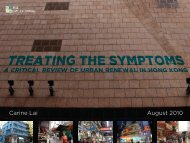Untitled - Civic Exchange
Untitled - Civic Exchange
Untitled - Civic Exchange
You also want an ePaper? Increase the reach of your titles
YUMPU automatically turns print PDFs into web optimized ePapers that Google loves.
Chapter 7:<br />
The Dynamics of Decision-making in Hong Kong<br />
fundamentally flawed and needs to be redone. The following examples highlight the potential benefits of<br />
ERP and indicate the urgent need to re-assess this option in a comprehensive and transparent manner.<br />
If road pricing was introduced in those areas of Hong Kong where air pollution, noise levels, and<br />
congestion are particularly acute:<br />
• Charging all passenger vehicles except buses (and perhaps school buses) would induce people to<br />
leave their private cars at home and use high occupancy road and rail transport.<br />
• Charging buses would induce bus operators to consider bus scheduling and routing more carefully<br />
so as to avoid running nearly empty buses in priced areas. 276<br />
• Charging goods vehicles and other industrial vehicles could discourage businesses from<br />
contributing to congestion at peak times and encourage them to shift the time of their operations to<br />
off-peak periods (see Chapter 5).<br />
Case Study 4: Trams and Electric Trolley Buses<br />
The feasibility of trams and electric trolley buses for Hong Kong is addressed in Chapter 5. Trams and<br />
electric trolley buses produce no pollution at street level and generate less noise than buses. Considering<br />
the unhealthy quality of air at street level and the widespread exposure to traffic noise in Hong Kong's<br />
urban areas, these technologies would seem to offer an attractive option worthy of in-depth government<br />
assessment. However, this does not appear to have been the case. 277<br />
Modern trams, such as those in operation in various European cities, were not mentioned in CTS3,<br />
although the report concludes that Hong Kong's existing "antique" trams should continue to operate -<br />
without expansion of services - to provide feeder service for heavy rail. 278 The major limitations of trams<br />
are that they are restricted to flat or nearly flat areas and, being heavy, may require strengthening of<br />
roadbeds. In Hong Kong, trams are best suited to reclaimed areas that tend to be very flat, such as the<br />
northern shoreline of Hong Kong Island. However, trams could also be introduced in much of the Kowloon<br />
peninsula (particularly in new reclaimed areas 279 ) and in parts of the New Territories. 280 Trams can also be<br />
used imaginatively in conjunction with pedestrian schemes, such as those being proposed by the Hong<br />
Kong Institute of Planners. 281<br />
Like trams, electric trolley buses are a long-established technology used worldwide. Citybus, one of Hong<br />
Kong's franchised bus operators, has expressed interest in this technology and is now testing electric trolley<br />
buses at its Aberdeen depot. CTS3 stated that:<br />
"Before recommendation to trolley buses could be made, there should have to be confirmation of the<br />
276 A key criticism of Hong Kong's current transport system is the vast number of empty buses in urban areas,<br />
particularly in Central, which are a major cause of congestion and an important source of air and noise pollution.<br />
Transport officials have been unsuccessful in dealing with this issue due to the failure to develop a clear policy on<br />
competition and coordination between transport modes. See Chapter 3 for more on this point.<br />
277 Chapter 5 compares trams and electric trolley buses with diesel buses in terms of air and noise pollution.<br />
278 Transport Department (1999), Third Comprehensive Transport Study: Technical Report, Hong Kong: HKSAR<br />
Government.<br />
279 An ideal area would be the planned South East Kowloon reclamation.<br />
280<br />
Introduction of modern tram service would be very suitable in Tseung Kwan O, a large new development where<br />
government planners failed to consider options for eliminating transport-related local pollution during site design.<br />
281 The Des Voeux Road Central Pedestrianisation Focussed Study, Final Report, produced by the Hong Kong<br />
Institute of Planners in April 2001, and other pedestrian schemes are discussed further in Chapter 4.<br />
87

















